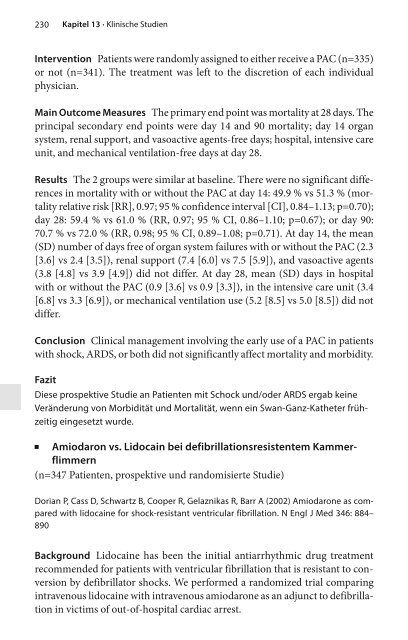Intensivmedizin Fragen und Antworten
Erfolgreiche ePaper selbst erstellen
Machen Sie aus Ihren PDF Publikationen ein blätterbares Flipbook mit unserer einzigartigen Google optimierten e-Paper Software.
230 Kapitel 13 · Klinische Studien<br />
Intervention Patients were randomly assigned to either receive a PAC (n=335)<br />
or not (n=341). The treatment was left to the discretion of each individual<br />
physician.<br />
Main Outcome Measures The primary end point was mortality at 28 days. The<br />
principal secondary end points were day 14 and 90 mortality; day 14 organ<br />
system, renal support, and vasoactive agents-free days; hospital, intensive care<br />
unit, and mechanical ventilation-free days at day 28.<br />
Results The 2 groups were similar at baseline. There were no significant differences<br />
in mortality with or without the PAC at day 14: 49.9 % vs 51.3 % (mortality<br />
relative risk [RR], 0.97; 95 % confidence interval [CI], 0.84–1.13; p=0.70);<br />
day 28: 59.4 % vs 61.0 % (RR, 0.97; 95 % CI, 0.86–1.10; p=0.67); or day 90:<br />
70.7 % vs 72.0 % (RR, 0.98; 95 % CI, 0.89–1.08; p=0.71). At day 14, the mean<br />
(SD) number of days free of organ system failures with or without the PAC (2.3<br />
[3.6] vs 2.4 [3.5]), renal support (7.4 [6.0] vs 7.5 [5.9]), and vasoactive agents<br />
(3.8 [4.8] vs 3.9 [4.9]) did not differ. At day 28, mean (SD) days in hospital<br />
with or without the PAC (0.9 [3.6] vs 0.9 [3.3]), in the intensive care unit (3.4<br />
[6.8] vs 3.3 [6.9]), or mechanical ventilation use (5.2 [8.5] vs 5.0 [8.5]) did not<br />
differ.<br />
Conclusion Clinical management involving the early use of a PAC in patients<br />
with shock, ARDS, or both did not significantly affect mortality and morbidity.<br />
Fazit<br />
Diese prospektive Studie an Patienten mit Schock <strong>und</strong>/oder ARDS ergab keine<br />
Veränderung von Morbidität <strong>und</strong> Mortalität, wenn ein Swan-Ganz-Katheter frühzeitig<br />
eingesetzt wurde.<br />
jAmiodaron vs. Lidocain bei defibrillationsresistentem Kammerflimmern<br />
(n=347 Patienten, prospektive <strong>und</strong> randomisierte Studie)<br />
Dorian P, Cass D, Schwartz B, Cooper R, Gelaznikas R, Barr A (2002) Amiodarone as compared<br />
with lidocaine for shock-resistant ventricular fibrillation. N Engl J Med 346: 884–<br />
890<br />
Backgro<strong>und</strong> Lidocaine has been the initial antiarrhythmic drug treatment<br />
recommended for patients with ventricular fibrillation that is resistant to conversion<br />
by defibrillator shocks. We performed a randomized trial comparing<br />
intravenous lidocaine with intravenous amiodarone as an adjunct to defibrillation<br />
in victims of out-of-hospital cardiac arrest.


